Related Research Articles

Transport in Norway is highly influenced by Norway's low population density, narrow shape and long coastline. Norway has old water transport traditions, but road, rail and air transport have increased in importance during the 20th century. Due to the low population density, public transport is somewhat less built out in rural areas of Norway, however public transport in, and around cities is well developed.
Trondheim Toll Scheme or Trondheim Package was the result of that in the 1980s politicians and road authorities in Trondheim, Norway wanted to accelerate the investments in roads and motorways around the city through an investment package and toll scheme to ease construction and generate more funds. Between 1991 and 2005, there were more than 20 toll plazas throughout the city that help finance the new roads. Toll plazas will still remain east of the city at least until 2012. The toll collection is administrated by Trøndelag Veifinans.
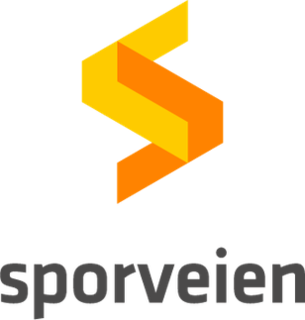
Sporveien Oslo AS is a municipally owned public transport operator in Oslo, Norway. It operates the trackage and maintains the stock of the Oslo Metro and Oslo Tramway, as well as owning eight operating subsidiaries. In 2005, its 2,365 employees transported 160 million passengers 710 million kilometers, and since 2008 it has operated on contract with the public transport authority Ruter.
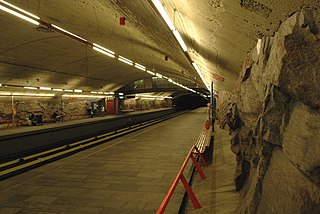
The Grorud Line is a 13.0-kilometer long (8.1 mi) line on the Oslo Metro between Tøyen and Vestli in Oslo, Norway. Built as a mix of underground, at ground level and as an elevated line, it runs through the northern part of Groruddalen, serving such neighborhoods as Grorud, Romsås and Stovner. Line 5 runs along the entire line four times per hour. Line 4 runs between Vestli and Økern before branching off on the Løren Line to get onto the Ring Line. With 40,000 daily riders, the Grorud Line is the busiest branch of the metro.

The Furuset Line is a 5.6-kilometer (3.5 mi) long line on the Oslo Metro between Hellerud and Ellingsrudåsen in Oslo, Norway. Running mostly underground, it passes through the southern part of Groruddalen, serving neighborhoods in the boroughs of Alna and Furuset. The line is served by Line 2 of the metro with four or eight trains per hour. The line is owned by Kollektivtransportproduksjon and operated by Oslo T-banedrift on contract with Ruter using MX3000 trains.
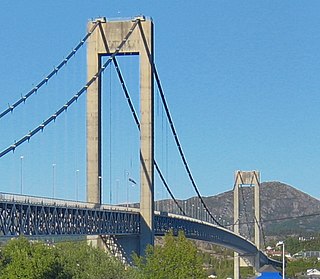
The Sotra Bridge is a suspension bridge which crosses Knarreviksundet between Knarrevik in Øygarden Municipality and Drotningsvik on the mainland of Bergen Municipality in Vestland county, Norway. It carries two road lanes and two narrow pedestrian paths of National Road 555, providing a fixed link for the archipelago of Sotra. The bridge is 1,236 metres (4,055 ft) long, has a main span of 468 metres (1,535 ft) and a clearance of 50 metres (160 ft). In 2007, it had an average 25,494 vehicles per day.

The Ring Line is the newest rapid transit loop line of the Oslo Metro of Oslo, Norway. It connects to the Sognsvann Line in the west and the Grorud Line in the east; along with these two lines and the Common Tunnel, the Ring Line creates a loop serving both the city centre and Nordre Aker borough. The 5.0 kilometres (3.1 mi)-long line has three stations: Nydalen, Storo and Sinsen. Four-fifths of the line runs within two tunnels, with the 1.0-kilometer (0.62 mi) section between Storo and Sinsen, including both stations, being the only at-grade part. The line connects to the Grorud Line north of Carl Berners plass and with the Sognsvann Line north of Ullevål stadion.
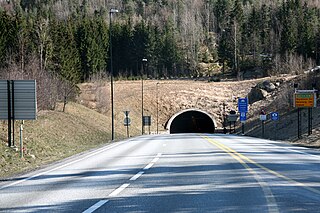
The Oslofjord Tunnel is a subsea road tunnel which traverses the Oslofjord, connecting Hurum and Frogn in Norway. Carrying three lanes, the 7,306-meter (23,970 ft) long tunnel reaches a depth of 134 meters (440 ft) below mean sea level. The tunnel has a maximum gradient of seven percent. It acts as the main link connecting eastern and western Viken county, supplementing the Moss–Horten Ferry which runs further south. The tunnel is since 2018 a part of European route E134, until 2018 it was part of National Road 23.

The Asker Line is a 9.5-kilometre (5.9 mi) railway line between Asker and Lysaker in Norway. The line runs along the same corridor as the Drammen Line, offering increased capacity, speed and regularity on the rail network west of Oslo. The first part opened in 2005, and in 2011 an extension opened from Sandvika to Lysaker. Original plans called for an extension to Skøyen, but from 2020, new planning is under way for an extension all the way to Oslo Central Station. Most of the railway is in tunnel and is dimensioned for 160 km/h (99 mph) running. The entire railway is electrified at 15 kV 16.7 Hz AC. The first section cost 3.7 billion kr, while the second is budgeted at NOK 2.7 billion.
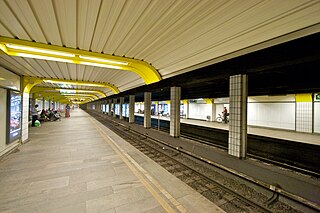
The Common Tunnel, sometimes called the Common Line, is a 7.3-kilometer (4.5 mi) long tunnel of the Oslo Metro which runs through the city center of Oslo, Norway. The name derives from the fact that all six lines of the metro use the tunnel, which runs from Majorstuen to Tøyen. The section has six stations, including the four busiest on the metro.
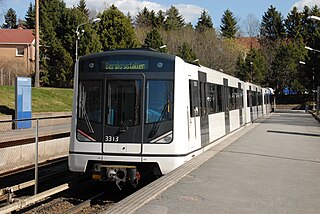
MX3000 is an electric train used on Oslo Metro in Oslo, Norway. The multiple units are produced by Siemens Mobility, who started serial delivery in 2007. Seventy-eight three-car units were ordered by Sporveien, and five by Akershus County Municipality. They replaced the older T1000 and T1300 stock that was used on the Oslo Metro since 1966. By 2010, the last T1000 and T1300 trains had been retired and replaced by 83 three-car units. 32 additional sets were ordered, and the final train set was delivered in 2014, increasing the fleet to 115 units.
Ruter AS is the public transport authority for Oslo and Akershus counties in Norway. Formally a limited company – 60% of its shares are owned by the Oslo county municipality and 40% by that of Akershus – it is responsible for the administration, funding, and marketing of public transport in the two counties, including buses, the Oslo Metro, Oslo Trams, and ferry services. Ruter also holds agreements with Norwegian State Railways concerning the regulation of fares on local and regional train services operated within the two counties.
Fjellinjen AS is a toll company owned by the City of Oslo (60%) and Viken County Municipality (40%). It is responsible for the collection from the toll ring around Oslo, with a total of nineteen toll plazas. All toll roads in Norway have a toll road operator responsible for the financing of the road project. The right to demand payment of toll charges is granted when a toll charge agreement is entered into with the Norwegian Public Roads Administration.
Oslo Package 3 is a political agreement and plan for investments of 53 billion kr in Oslo and Akershus, Norway. It involves financing for road and public transport infrastructure, as well as operating subsidies to public transport in the period 2008–27. It will be part of the National Transport Plan 2010–19. In addition to state grant, the main financing will be through toll ring around Oslo. The plan is a follow-up on its predecessors, the Oslo Package 1 and Oslo Package 2.

The Granfoss Tunnel is a set of two tunnels on Ring 3 in Oslo, Norway. The two tunnels are 2.1 kilometers (1.3 mi) long and they are part of the Granfoss Line, a 2.9-kilometer (1.8 mi) stretch of motorway which was opened in 1992 connecting Ring 3 with the European route E18. The name comes from the Granfossen waterfall on the Lysakerelva river, which passes nearby. The two tunnels run from Lysaker to Mustad, and from Mustad to Ullern Church, respectively.

Oslo Package 1 was a political agreement and plan for introducing an urban toll ring around Oslo, Norway, and making 31 investments to road infrastructure in Oslo and Akershus. The package was approved in 1988, and toll charges were introduced in 1990. It was supplemented by Oslo Package 2, which included a similar scheme for public transport. In 2008, they were both replaced by Oslo Package 3.

The Bjørvika Tunnel is a motorway immersed tunnel on European Route E18 in the city center of Oslo, Norway. The tunnel has two bores, with three lanes in each. In the west, it connects to the Festning Tunnel at Akershus Fortress and runs under the Bjørvika arm of the Oslofjord before ending in an intersection on the east shore, where it splits into Mosseveien (E18) and the Ekeberg Tunnel. The tunnel is 1,100 metres (3,600 ft) long, 675 meters of which run below sea level, and opened in September 2010. It was built by the Norwegian Public Roads Administration The Bjørvika Tunnel is part of the Opera Tunnel complex which is the name of the interconnected system of tunnels between Ryen and Filipstad. The Bjørvika Tunnel is the first immersed tunnel in Norway.
The county of Oslo shares the same name as the Norwegian capital city and has an extensive transportation infrastructure system. The public transportation system includes buses, trams, metro lines and airports. Railways and roadways connect the city to the rest of Norway and locations in neighboring countries.

National Road 23, also known as the Oslofjord Link, was the name of a 40.2 kilometers (25.0 mi) largely limited-access road which connects the municipalities of Lier, Røyken, Hurum and Frogn in Norway. The 7.2-kilometer (4.5 mi) Oslofjord Tunnel causes the road to acts as the only fixed link crossing of the Oslofjord and makes that section subject to tolls. In 2018 the road was renamed into European route E134.
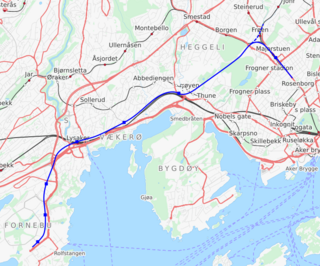
The Fornebu Line is an under construction rail line which will serve the peninsula of Fornebu in Bærum, Norway. The line is under construction and the transit agency Ruter is working towards connecting it to the Oslo Metro. The line has at various stages been proposed as an automated people mover, tram-train, tramway, light rail, stadtbahn, rapid transit, bus rapid transit and commuter rail, with the rapid transit option being selected as the final proposal. The metro line will start at Majorstuen Station and will run entirely in a tunnel for 8,150 meters (26,740 ft). The line will have six stations, at Skøyen, Vækerø, Lysaker, Telenor Arena, Flytårnet and Fornebu Senter. A depot will be built at Fornebu and the line will connect to the metro's Common Tunnel at Majorstuen.
References
- ↑ Oslo Package 2. "O2 på 1-2-3" (in Norwegian). Retrieved 2008-12-03.
- 1 2 Oslo Package 2. "Historikk" (in Norwegian). Retrieved 2008-12-03.
- ↑ Office of the Auditor General of Norway. "Målet om økt kollektivandel og bærekraftig transport er ikke styrende for Oslopakke 2 - Dokument nr. 3:8 (2005-2006)" (in Norwegian). Archived from the original on February 28, 2007. Retrieved 2008-12-03.
- 1 2 Oslo Package 2. "Finansiering" (in Norwegian). Retrieved 2008-12-03.